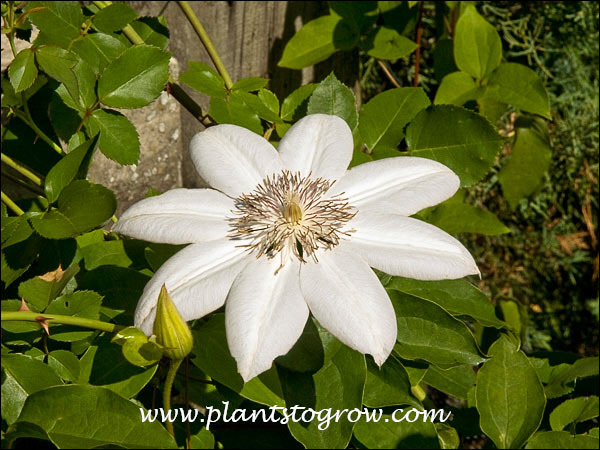| Description | An antique, deciduous vine Clematis with large single white flowers. |
|---|---|
| Pronunciation | (KLEM-uh-tiss) |
| Plant Type | All Plants, Vines |
| Hardiness Zone | 4-9 |
| Sunlight | full, part sun |
| Moisture | average |
| Soil & Site | average |
| Flowers | eight tepals, 6-8" in diameter, white flowers with purplish brown anthers |
| Leaves | deciduous vine |
| Dimensions | 6-8 feet, vine |
| Maintenance | (Group "B" pruning) Proper pruning will do much to ensure a spectacular display. Basically you want to prune lightly, removing dead and weak wood first so as to get a better view of the plant. Remember that the largest flowers will be produced on old wood, so you don't want to remove too much. Prune slowly from the top until you reach a good bud, one stem at a time. If the stems are growing together in a jumble, this is the time to carefully untangle by cutting the old leaf petioles to sever the stems from the support. Spread them out and reattach with twist ties. As the new growths emerge in the spring you can train them as you wish. If and when a "B" clematis has outgrown its space and it needs remedial pruning or rejuvenation, meaning a hard cutting back, this can be accomplished after the spring flowering and still leave plenty of time for the new shots to mature for a good fall display (www.clematisnursery.com) |
| Propagation | division, layering, basal cuttings, |
| Cultivar Origin | Raised by Isaac Anderson-Henry of Edinburgh Scotland. A cross between C. lanuginosa x C. Foortunei in 1870. |
| Misc Facts | (syn. C. angustifolia) |
| Notes & Reference | #84-An Illustrated Encyclopedia of Clematis (Mary Toomey, Everett Leeds), www.clematisnursery.com |

Cart

